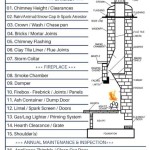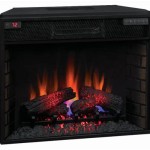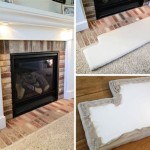Refacing A Brick Fireplace With Wood: A Comprehensive Guide
Brick fireplaces, while often a charming architectural feature, may sometimes clash with an updated or desired aesthetic. Instead of demolishing and rebuilding, refacing with wood presents a viable and cost-effective alternative. This process allows homeowners to maintain the functionality of the fireplace while achieving a completely new look. Refacing a brick fireplace with wood can dramatically transform a room, adding warmth, character, and a touch of modern elegance or rustic charm, depending on the chosen wood and design.
Before embarking on the project, careful planning is crucial. This involves assessing the existing brick structure, choosing the appropriate wood material, and understanding the necessary safety precautions. A thorough understanding of these aspects will contribute to a successful and aesthetically pleasing outcome.
Assessing the Existing Brick Fireplace and Planning the Design
The first step involves a comprehensive inspection of the brick fireplace. Look for any signs of damage, such as cracks, loose bricks, or crumbling mortar. These issues need to be addressed before any refacing work begins. Ignoring existing structural problems can compromise the stability of the new wooden facade and potentially pose a safety hazard.
Measure the dimensions of the fireplace carefully. This includes the height, width, and depth of the firebox opening, the mantel, and the surrounding brick structure. Accurate measurements are essential for creating a well-fitting and visually appealing wooden frame. Consider the overall design aesthetic of the room and choose a wood type and style that complements the existing decor. Options range from sleek and modern designs using hardwoods like maple or walnut to more rustic and traditional looks incorporating reclaimed wood or knotty pine.
Consider the fireplace's functionality. If it's a working fireplace, adherence to building codes is paramount. Ensure that the wooden refacing material is installed with appropriate clearances from the firebox to prevent any fire hazards. Non-combustible materials, such as cement board, may need to be installed behind the wood to provide a fire-resistant barrier. Researching local building codes and obtaining necessary permits before starting the project is always recommended.
Finally, create a detailed plan or sketch of the desired design. This will serve as a visual guide throughout the refacing process and help ensure that the finished product meets expectations. Include measurements, material specifications, and any unique design elements in the plan.
Selecting the Right Wood and Materials
The choice of wood is a critical factor in the success of the refacing project. Different wood species offer varying aesthetic qualities, durability, and fire resistance. Hardwoods, such as oak, maple, and walnut, are known for their durability and elegant grain patterns. Softwoods, like pine and cedar, are often more affordable and easier to work with, but may require more frequent maintenance.
Consider using fire-resistant wood products specifically designed for fireplace surrounds. These materials are treated with fire retardants and can withstand high temperatures. Cement board, a non-combustible material, can be used as a substrate behind the wood to provide an additional layer of fire protection. Proper ventilation is also essential to prevent heat buildup and ensure safe operation of the fireplace.
Beyond the wood itself, other materials are needed for the refacing process. These include construction adhesive, screws or nails, wood filler, sandpaper, primer, and paint or stain. Choose high-quality products that are specifically designed for wood and masonry applications. Consider using a clear sealant or varnish to protect the wood from moisture and wear, especially if the fireplace is located in a high-humidity environment.
Also, invest in the right tools. A circular saw, miter saw, drill, level, measuring tape, and safety glasses are essential for this project. Having the appropriate tools makes the job easier and ensures a more accurate and professional-looking result.
The Refacing Process: Step-by-Step
Once the design is finalized and the materials are gathered, the refacing process can begin. Start by thoroughly cleaning the brick surface. Remove any loose debris, dirt, or soot using a wire brush and a mild detergent solution. This will ensure that the adhesive properly bonds to the brick.
Next, install the cement board backing, if required. Cut the cement board to the desired size and shape using a utility knife or circular saw. Attach it to the brick surface using construction adhesive and screws. Ensure that the cement board is securely fastened and flush with the brick.
Cut the wood pieces according to the measurements in the plan. Use a miter saw to create clean and precise angles for the corners and edges. Before attaching the wood to the fireplace, consider pre-finishing it with stain or paint. This can be done in a well-ventilated area and will make the final finishing process easier.
Apply construction adhesive to the back of the wood pieces and carefully position them on the fireplace. Use screws or nails to further secure the wood to the brick or cement board. Ensure that the wood is level and plumb. Use wood filler to fill any gaps or imperfections. Once the filler is dry, sand the surface smooth.
Finally, apply a primer and paint or stain to the wood. Choose a color or finish that complements the room's decor. Apply multiple coats, allowing each coat to dry completely before applying the next. A clear sealant or varnish can be applied to protect the wood from moisture and wear.
Safety is paramount throughout the entire refacing process. Always wear safety glasses and gloves when working with wood and power tools. Ensure adequate ventilation when using adhesives, paints, or stains. Carefully follow the manufacturer's instructions for all materials and tools.
Refacing a brick fireplace with wood is a rewarding project that can significantly enhance the aesthetic appeal of a home. Careful planning, proper material selection, and adherence to safety guidelines are essential for a successful outcome.

Diy Fireplace Makeover Wood Slat

How To Cover A Brick Fireplace With Wood Stone Nina Hendrick Home

How I Refaced My 1970 S Brick Fireplace Easily And Inexpensively

Diy Fireplace Makeover Wood Slat

A Step By Guide To Fireplace Refacing Diy Family Handyman

Brick Fireplace Ideas How To Update A

Diy Refacing Fireplace Makeover Idea Reface Brick Wall

How To Reface A Fireplace Surround In 6 Steps

Fireplace Refacing So You Want To Bob Vila

How To Reface A Fireplace We Love Fire








